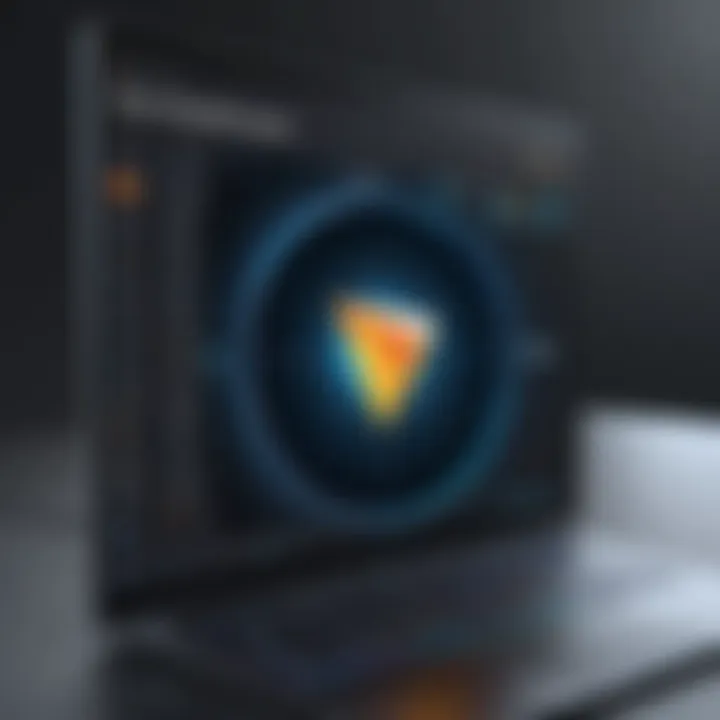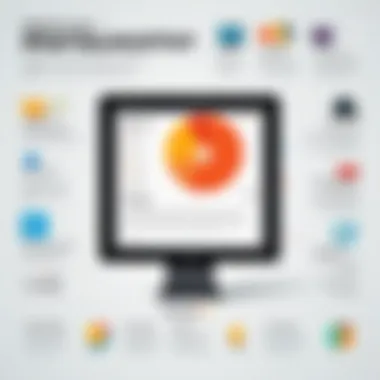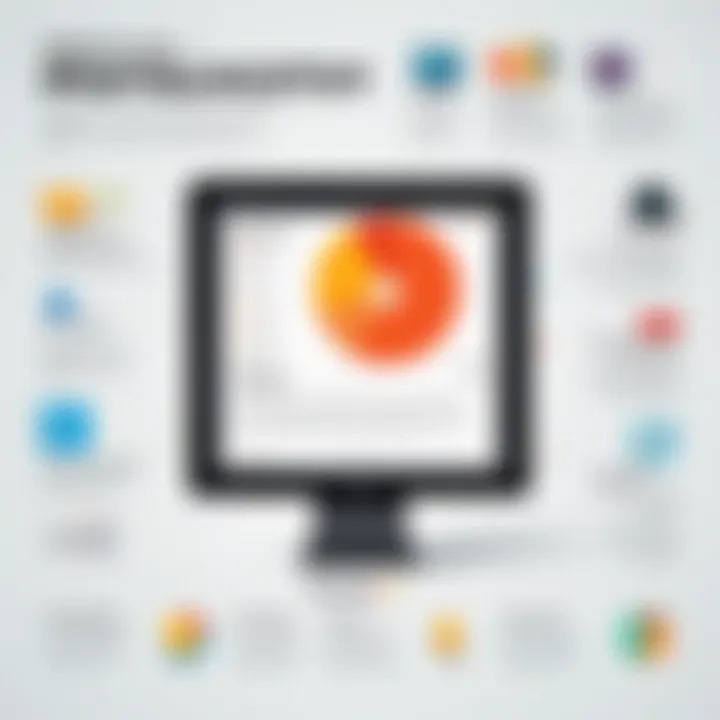Understanding Right Click Media and Its Impact


Intro
Navigating the landscape of digital tools can sometimes feel like traversing a labyrinth. One often overlooked yet powerful aspect of our interactions with technology is the right click. It’s not just a mere convenience; it’s a fundamental gateway to enhanced functionality and efficiency. Understanding this seemingly simple yet multifaceted feature can empower users to take full advantage of their devices.
Overview of the Technology
The right click interface has its roots in the early days of personal computing, evolving substantially since the introduction of the mouse. More than just a secondary button on our mice, the right click functions as an intuitive means to access a wealth of options with minimal effort.
Key specifications
While specifications may vary between devices, the essence of right click technology remains universal. Here are some key points:
- Contextual Menus: The primary feature activated by right clicking. It provides a tailored list of actions that relate to the item or area clicked.
- Accessible Shortcuts: Many programs leverage right click to offer quick access to frequently used features, enhancing workflow efficiency.
- Hardware Compatibility: Most modern devices, whether they’re laptops, desktops, or tablets, include a right click option, either through hardware or touch gestures.
Unique selling points
The right click mechanic has several strengths that distinguish it from other forms of user interaction:
- Enhanced User Experience: Provides quicker access to actions that would otherwise require multiple clicks or navigating through menus.
- Customizability: Users can often modify right-click options on many applications, tailoring the experience to their specific needs.
- Collaboration Tools: In shared documents or platforms, right-click menus can facilitate multi-user interactions, highlighting the feature's importance in modern communication tools.
Design and Build Quality
As crucial as the functionality is, the design of the right click interface also plays a significant role in its effectiveness.
Material used
Most computer mice or touchpads are crafted from durable plastic, rubber, or other materials that seamlessly incorporate functionality and ergonomic comfort. Each material complements the mechanics of right click, ensuring longevity and reliability.
Ergonomics and usability
A well-designed mouse should feel natural in hand. Right-click buttons are often positioned strategically to minimize strain and maximize responsiveness. Many ergonomic mice allow the user to rest their hand comfortably while accessing both left and right clicks fluidly. This consideration enhances usability, making the right click not just a necessity but a pleasure to engage with.
"Understanding the subtle nuances of right click media can significantly influence productivity in our digital interactions."
Understanding Right Click Media
In an increasingly digital age, grasping the ins and outs of right click media is not just beneficial; it’s essential for anyone looking to navigate the constantly evolving tech landscape. This section sets the stage for understanding how the right click functionality plays a pivotal role in enhancing user interactions with a wide array of applications and platforms. By unraveling its significance, we can better appreciate how something as simple as a right-click can fundamentally transform our experience with technology.
The importance of mastering right click media lies in its ability to streamline tasks and improve productivity. With a simple click of the right mouse button, users are presented with options that can save time, simplify navigation, and offer personalized functionalities based on context. Whether it’s copying files, opening links in new tabs, or accessing additional features of software, understanding these capabilities can deeply influence the way individuals and organizations optimize their workflows.
Definition of Right Click Media
Right click media pertains primarily to the actions and functions triggered by a right-click on a computer interface. Essentially, it refers to the contextual menus and shortcuts that appear upon right-clicking an item, be it on a desktop application, a website, or within a mobile app. These menus are tailored to deliver options relevant to the selected item or area, thus providing a versatile tool for users.
For instance, when right-clicking on a file in a desktop environment, users might see options such as "Open," "Rename," or "Delete." In contrast, right-clicking on a webpage might offer options such as "Open link in new tab" or "Inspect element." This adaptability makes right click media not just a feature but a fundamental aspect of user interface design that speaks to efficiency and user control.
Historical Context
To fully appreciate the significance of right click media today, it’s crucial to look back at its development. The origins of the right-click function can be traced back to the early graphical user interfaces (GUIs) of the 1980s, notably in systems like the Apple Macintosh and Microsoft Windows. At that time, the primary focus was to provide a more intuitive way for users to interact with their computers as opposed to the text-based command lines of earlier systems.
The right click functionality gained traction as a tool for enhancing user experience, allowing for more options in a compact interface. Over the years, software developers have expanded the functionalities associated with right clicks, consistently aiming to make user interactions more intuitive and efficient. This evolution reflects a broader trend in technology: the drive towards increasing usability without cluttering screens with excessive buttons or options.
In essence, the history of right click media mirrors the journey towards enhancing user autonomy in navigating software interfaces.
Today, as technology becomes an integral part of daily life, understanding the historical context of right click media helps users appreciate its nuances and empowers them to make better use of it, whether in personal use or professional settings. Thorough knowledge of these features is a substantial asset in boosting productivity and ensuring a smoother digital experience.
The Functionality of Right Click Actions
Understanding the functionality of right click actions is critical in today’s digital age. Not only do these actions streamline tasks, but they also significantly enhance our interactions with various digital environments. The right click offers a myriad of options that cater to user needs, allowing for a more intuitive and quicker experience across platforms. Users who fully grasp how to leverage these functionalities can navigate their tools with remarkable ease, ultimately elevating their productivity.
Common Right Click Options


When diving into common right click options, the benefits become clear. These features can save time and provide access to frequently used actions at the tip of your fingers, or rather, the tip of your mouse. Here’s a breakdown:
- Copy: Quickly duplicate text, images, or files. This is a fundamental function that arises in nearly all contexts, making the cut-paste routine a breeze.
- Paste: Place whatever you’ve copied directly where you need it. It’s astonishing how often this simple option is key in producing content efficiently.
- Delete: A quick option to dispose of unwanted items that works equally well in file management or document editing.
- Properties: This option lets users dive deeper into the specs of a file or application. Understanding the technical aspects can help users troubleshoot or optimize usage.
- Refresh: Especially useful in web browsing contexts, refreshing the page can solve a myriad of small glitches or simply present updated content.
On a broader scope, these actions enable users to engage with their systems in ways that can feel natural and seamless. For instance, a student studying online can effortlessly copy notes from one document to another, enhancing learning without the constant fumbling about.
Contextual Menus Explained
Contextual menus are these neat little pop-ups that appear when you right click on an item. They adapt based on what you select, offering tailored choices directly relevant to the action you want to undertake. This selective display allows users to access functions fast without wading through multiple layers of menus.
Imagine you're working on a project and you have a variety of images to sort through. Right clicking on an image brings forth editing options directly related to that image, like resizing or applying filters. This means the actions are context-sensitive and can dramatically affect one’s workflow.
Using contextual menus efficiently means less time wasted navigating through more complex menus and more time being productive in our tasks.
They can often include options like:
- Open With: Choose a specific application designed for certain file types, promoting a flexible work environment.
- Send to: Quickly send files via email or transfer them to relevant applications. This can aid in better collaboration among teams.
- New Folder: Easily create new folders in a file explorer to enhance organization at structure level.
Applications Across Platforms
In today’s digital landscape, understanding the applications of right click media across various platforms is akin to holding the key to a treasure chest of functionality. The right click action may seem trivial, but it serves as a gateway to numerous features that can enhance user experience and promote productivity. With each platform offering its unique set of options, adeptness at utilizing these tools can make interactions smoother, allowing users to traverse through tasks with remarkable efficiency.
Desktop Environments
When it comes to desktop environments, right click options are often integrated deeply into the workflow. For example, on systems like Microsoft Windows, right clicking on a file provides a plethora of actions, from basic copy and paste to more advanced functionalities such as sharing or accessing properties. These options can save time—particularly for power users who work on complex projects.
- Quick Access: Users can quickly create new folders, access context menus for different applications, or even send files to various recipients with a simple right click.
- Streamlined Workflows: The ease of dragging and dropping files or shortcuts within a right-click menu allows seamless organization of files and documents.
In a macOS environment, right-clicking brings up a similar but distinctively designed interface. The Apple ecosystem emphasizes clean aesthetics, so not only does right clicking yield additional options, but it also does so with a visually appealing touch. Implementing gestures like two-finger clicks on a trackpad can also enhance navigation further, catering to user preferences.
Web Browsers
Web browsers are perhaps where the right click feature shines the brightest. Every webpage’s context-sensitive menu brings a host of capabilities, from opening links in new tabs to inspecting page elements. Imagine a researcher sifting through countless articles; the right click function streamlines tasks such as:
- Saving Links: Quickly saving links to bookmark folders without disrupting the browsing experience.
- Image Options: Saving images in different formats can be crucial depending on the project needs, whether for a presentation or blogging.
- Developer Actions: Developers appreciate right click actions for inspecting elements or accessing console tools, which can simplify debugging and enhance code development.
Moreover, right clicking on a blank space lets users reload or print pages with ease, preferences that cater to regular internet users and professionals alike.
Mobile Devices
On mobile devices, the concept of right click morphs into long-press actions, but its implications remain just as significant. Such gestures provide context-specific options that facilitate active engagement with the platform. For instance, in many mobile applications:
- Menu Access: Users can long-press to copy text, share items, or delete applications directly from their home screens.
- Multitasking: Quick menu options allow users to switch between applications with little delay, optimizing their flow.
However, the touch interface can come with its nuances. Not all apps harness long-press features to their fullest. Some users may find certain apps lacking intuitiveness, missing out on potential usability benefits.
Impact on User Experience
User experience isn’t just a buzzword tossed around by designers and marketers. It’s the very essence of how people engage with technology. When it comes to right click media, its impact on user experiences is undeniably profound. Right clicking, often taken for granted, provides a seamless bridge between simple navigation and efficient task management. With a mere click, users can access options that traditionally require several steps, ultimately shaping how they interact with their digital environments.
Enhancing Productivity
In today’s fast-paced world, efficiency is king. Every second counts, and having tools that cater to quick access can lead to remarkable improvements in productivity. Right click functions facilitate this by offering a shortcut to essential features. For instance, in many desktop environments, right clicking on a file allows users to swiftly copy, move, or delete it without the need to navigate through multiple menus. This straightforward approach dramatically cuts down time and minimizes disruption in workflow.
Imagine a graphic designer who needs to adjust layers in a complex design. Instead of fiddling through endless options in a toolbar, she can simply right click on a layer to gain immediate access to options like duplicating, merging, or even deleting. This not only simplifies her tasks but allows her to maintain a flow of creativity, vastly enhancing productivity across various workflows.
Furthermore, many web browsers have right-click functions that enable users to open links in new tabs or save images with ease. This aspect integrates directly into daily browsing habits, as web users can consume information more fluidly. With every right click, there is the potential for a more effective interaction with online content, trimming away unnecessary actions that might lead to frustration.
"A user-centered design not only improves the user experience but also enhances the overall productivity by streamlining necessary tasks and processes."
Navigational Benefits


Navigation is one of the key elements in technology that can significantly affect how users interact with software and platforms. Right click media paves a smoother path for navigating complex environments. For instance, when utilizing software like Microsoft Word, right clicking within a document can instantaneously provide options for formatting or spell-checking, eliminating the need to search through menus or toolbars. This not just saves time, it empowers the user with tools designed to enhance engagement with the content directly.
Moreover, for software developers, implementing a right-click context menu can elevate user experience to new heights. Users often feel more in control when they can easily access functionalities relevant to their immediate task without grappling with a cluttered interface. The ability to customize right-click menus can also enhance usability. Applications can be tailored to not only meet the needs of specific users but also to adapt over time as required by their usage patterns.
In the sphere of online platforms, right-click a webpage to gain access to options like printing, saving, or bookmarking without navigating away from the content you are viewing. This integrates natural browsing habits with advanced features, melding simple clicking with powerful functionalities.
This adaptable navigation aligns with a fundamental tenet in user experience: reducing cognitive load. The less effort users spend trying to figure out how to perform tasks, the more they can focus on their primary objectives. It's not merely about adding right-click options; it's about weaving them into the very fabric of interactions that make technology intuitive.
In essence, the impact of right click media transcends basic user satisfaction, touching upon productivity and navigational efficiency. As technology continues to evolve, the significance of these small actions becomes increasingly crucial in creating environments where users can thrive without unnecessary barriers.
The Evolution of Right Click Media
The journey of right click media is not just about a single functionality but an illustration of how user interactions have transformed over time. Understanding this evolution helps to appreciate not only the necessity of right click actions but also the practical implications they hold for the modern user. Initially, right clicks were simply a means of providing additional commands without clutter, but they have morphed into a cornerstone of user experience across various platforms.
The concept of right clicking came to life with the advent of graphical user interfaces in the 1980s. These interfaces allowed users to interact with their computers in a more intuitive manner. Back then, a right click was often limited to presenting a menu containing essential commands like copy, paste, and delete. This simplicity served a crucial purpose: it offered a way to navigate complex tasks without overwhelming the user with options scattered across the screen.
As computing technology progressed, the right click functionality underwent significant enhancements. More than just a means to an end, it became a way to streamline workflows, reduce unnecessary clicks, and ultimately improve user efficiency. The right click, once a mere addition, now represents a rich set of options and features that adapt based on context, offering a tailored experience. Today the right click menu can lead users to the heart of their tasks, making operations smooth and more enjoyable.
From Traditional Interfaces to Modern Usage
The transition from traditional interfaces to modern usage of right click media demonstrates how essential this functionality has become. In earlier days, users often relied on keyboard shortcuts alongside the primitive right click menu. The simplicity of commands made it easy for tech novices and seasoned users alike. Now, applications like Microsoft Word or Google Docs utilize the right click to offer context-specific options that assist users in real time.
In today’s mobile apps, the right click is often replicated with long-press gestures, tailoring the experience to different devices such as smartphones and tablets. A long press can replace a right click by unveiling a menu of relevant actions. This move is essential when considering how touch screens have revolutionized the way we engage with technology. Users now expect a similar functionality across devices, so the right click has expanded beyond mere desktop usage.
"The right click function is like the Swiss Army knife for digital interactions—multifunctional and always handy when you need it."
Future Trends
Looking towards the future, several trends indicate that right click media will continue to evolve. One possibility is the incorporation of artificial intelligence and machine learning into these functionalities. Imagine a right click menu that learns from user behavior—suggesting actions based on previously used commands or even predicting the next step in a task. This kind of personalization could drastically improve efficiency and satisfaction.
Furthermore, as virtual and augmented reality gain traction, the notion of right click could further transform. Interactions in a virtual space demand a rethinking of traditional gestures. How might a right click function change when users are engaging with 3D objects? The need for fluid interaction will drive innovations that redefine how we think about these actions.
Additionally, a growing emphasis on accessibility will shape the future of right click media. Developers are increasingly aware of the diverse needs of users, and they'll continue to innovate solutions that make interactions more inclusive. Ensuring right click options are easy to navigate for those with disabilities will no longer be an afterthought but rather a core design principle.
As we dissect the evolution of right click media, it becomes evident that it reflects broader technological advancements. By recognizing its historical significance and anticipating its future trajectories, users can stay ahead of the curve, harnessing the full potential of right click functionalities in their daily interactions with technology.
Enhancing Accessibility with Right Click Media
Accessibility is a vital aspect of technology that often receives insufficient attention. Right click media, a feature embedded in various digital interfaces, can play a significant role in enhancing accessibility for all users, especially for those with special needs. This section delves into how right click actions can be tailored to create a more inclusive user experience, spotlighting both the adaptability required for individuals with specific needs and the broader usability for the entire audience.
Adapting for Special Needs
When discussing accessibility, it is critical to acknowledge users who encounter challenges due to disabilities. Many operating systems and applications are now implementing features that exploit right click actions to enhance the experience for individuals with special needs. For instance, individuals with visual impairments can benefit from customized context menus that provide spoken descriptions of choices. By right-clicking on an element, a user might hear an audio prompt, guiding them through options that would be less accessible through standard shortcuts alone.
Imagine someone who has difficulty using a standard keyboard. Right click actions can be programmed to engage various functionalities through simplified voice commands, allowing users to perform tasks without needing to rely solely on traditional input methods.
- Voice Command Activation: Users can activate right click functionality through voice recognition, making tasks like copying or pasting more manageable.
- Tactile Feedback: Devices can provide tactile feedback when right click actions are engaged, assisting those who rely on touch to understand their interactions with digital content.
Initially, these adjustments may seem like small potatoes, but for users with specific needs, they can significantly redefine their digital experience. Crafting right click media with special needs in mind acknowledges a profound understanding of diversity in user ability.
Improving Usability for All
The value of right click media extends beyond accessibility for those with disabilities. It offers enhancements that all users, regardless of their technical proficiency or physical limitations, can appreciate. Simple changes can lead to a more efficient and user-friendly interface.
Right click menus can be structured to include shortcuts to frequently used features, resulting in smoother navigation through complex applications. Minimizing the number of clicks required to access functions saves time and effort for anyone. For example, instead of navigating through multiple menus to share a document, a user can simply right click and select the "Share" option immediately.
Points to consider for improving usability include:
- Contextual Options: Context-sensitive menus that adapt based on the user’s actions can create an intuitive environment where users anticipate available functions.
- Dynamic Shortcuts: As users familiarize themselves with applications, right click menus can evolve, showcasing features tailored to individual preferences.
- Consistent Design Principles: Adhering to uniform standards across different platforms ensures a cohesive experience, reducing the learning curve for new applications.
In summary, when properly designed, right click media serves not just a functional purpose but also enhances the overall usability of digital interfaces. By considering the diverse needs of users, software developers can ensure the right click feature becomes a powerful ally in creating an inclusive, efficient, and user-friendly environment.


"Access to technology should not be a privilege; it should be a right for all, regardless of their abilities." — An advocate for digital accessibility.
Navigating the complexities of user interaction through right click media opens the door to endless possibilities, transforming how individuals engage with technology.
Integrating Right Click Functions in Software Development
In the realm of software development, the art of integrating right click functions holds considerable weight. Developers stand at the helm of crafting user experiences, and a well-designed right click menu can significantly shape user interaction. It’s not just a frivolous feature; it’s a pivotal part of how users navigate and manipulate content. A thoughtfully designed right click function streamlines workflows and enhances accessibility, leading to more efficient applications.
One great benefit of including right click functions is that they offer a shortcut to various tasks, cutting down the need for users to rummage through menus or toolbar icons. Navigating large data sets or extensive document structures can be a hassle, but a right-click function can provide quick access to relevant tools or information, thereby keeping the workflow fluid and intuitive.
Best Practices for Developers
When incorporating right click functionalities into software, developers should follow some best practices to ensure that they serve their intended purpose:
- Consistency is Key: Users expect certain actions to be available from a right click. Whether it’s cut, copy, paste, or specific context actions, having these actions be consistent across applications helps in minimizing confusion.
- Customization Options: Empower users by allowing them to customize the options available in the right-click menu. This personalization can enhance usability, catering to varying user needs.
- Limit Menu Options: While it may be tempting to overload the menu with features, it’s prudent to keep it clipped. An overcrowded menu can overwhelm users and lead to poor navigation. Think of it like cooking; too many spices can ruin the dish.
User-Centered Design Principles
Shifting focus toward user-centered design principles is essential when considering the development of right click functions. This approach means prioritizing the end-user’s needs at every step during software design:
- User Testing: Prior to finalizing design, conducting user testing is invaluable. Observing real users interact with the right click menu can uncover areas that need tweaking or additional functionality.
- Simplicity and Clarity: Design should always aim to be straightforward. Users should glance at the right click menu and intuitively grasp its options and their purposes without needing a manual on how to decode it.
- Feedback Mechanisms: Integrating visual cues, such as highlighting or animations, can provide users with immediate feedback, reinforcing their choice and actions.
Adhering to these principles and practices isn’t merely about bolstering user satisfaction; it’s about aligning software design with real-world user behavior. As technology continues to evolve, understanding the role of right click functionality will be all the more vital in creating applications that resonate with users and enhance their digital experience.
"A good right click function is like a quiet, unobtrusive assistant, always there when you need it, enhancing productivity without monopolizing attention."
Designing with these elements in mind is not just beneficial; it’s a necessity to compete in the ever-changing landscape of software development.
Challenges and Limitations
While right click media offers numerous benefits to users, it also brings with it its own set of challenges and limitations that merit careful consideration. Understanding these intricacies is key to navigating the various platforms and addressing issues before they impede productivity or usability.
Common Issues Users Encounter
Right click actions, despite their intuitive design, can lead to frustrating user experiences from time to time. One recurring complaint relates to inconsistent behavior across different applications. For instance, a simple right click on a file in a file explorer might yield a set of options entirely different than right-clicking the same file within an email attachment. This inconsistency can leave users feeling disoriented, unsure of what actions are possible in various contexts.
Another common issue is the accidental right click. We've all been there, right? You meant to perform a left click, but in a moment of distraction, the right click occurs. The ensuing context menu can lead to unintended file moves or deletions.
Moreover, users working with simple touch devices, like tablets or mobile phones, may find it lackluster. Many rely solely on tap gestures, resulting in functionalities becoming buried or inaccessible. Ultimately, this issue diminishes the ability to maximize the tools at hand, hindering efficiency.
Platform-Specific Constraints
As technology continues to diversify, so too do the platforms on which right click media is utilized. Each platform has its own identity and behavior that can severely limit user interaction. For example, Windows OS allows a myriad of context menu options, yet it can quickly become overwhelming or confusing when someone is simply trying to copy text. The vast array of choices can slow down even seasoned professionals.
On the other hand, macOS typically offers a streamlined approach with its dual-finger tap on the trackpad. However, not all users appreciate this touch-based method; some prefer the traditional mouse but struggle to adapt to changing norms. Such divergence can create a steep learning curve, creating barriers for users transitioning between operating systems.
Furthermore, web-based applications may implement their own constraints. In browsers like Chrome or Firefox, the right click function often falls prey to web security measures. For instance, users trying to access the right click menu may find it blocked on certain websites, preventing straightforward interactions like saving images or copying text. This can be incredibly frustrating when users are attempting to streamline their workflow.
Overall, while right click media enhances the digital toolkit, it’s not without its hiccups. Understanding these challenges can help users navigate better and avoid pitfalls. It’s essential to stay informed and adaptable, ensuring that such limitations do not obscure the potential of right click functionality.
"Technology, while designed for ease, often presents its own unique puzzles."
Culmination and Reflections
In examining the realm of right click media, it becomes evident that this seemingly simple action embodies a range of implications for users across diverse technological landscapes. Right click interactions are not merely pragmatic; they resonate profoundly with the way individuals engage with their devices and platforms. Understanding these dynamics is essential for a comprehensive grasp of modern digital experiences.
Summarizing Key Insights
The various sections of this article elucidate several crucial insights regarding right click media:
- Functionality and Versatility: The capacity of right click actions to unlock contextual menus has transformed them into indispensable tools for productivity. Rather than following a linear path of navigation, users can now tailor their experience with precision, directly accessing options relevant to their immediate context.
- User Experience and Usability: One of the central benefits of right click media lies in its ability to enhance the overall user experience. Whether on desktop environments, web browsers, or mobile devices, the ease with which users can perform actions fosters a more intuitive interaction with technology.
- Evolution and Future Trends: The trajectory of right click media encompasses a rich history that reveals how traditional interfaces have evolved into modern usability features. As technology continues to advance, the role of right click actions will likely adapt, introducing fresh functionalities that cater to emerging needs and expectations.
- Accessibility Considerations: In our increasingly connected world, accessibility cannot be overlooked. Right click features can potentially bridge gaps for special needs users, improving overall usability. Developers play a vital role in ensuring these options are inclusive and user-friendly.
"Right click innovations can dictate not just how we navigate technology, but also how we personalize our interactions, making them a cornerstone of user efficiency."
Future Considerations in Right Click Media
Looking ahead, several pertinent considerations arise regarding the future of right click media:
- Adaptive Technologies: As machine learning and AI evolve, there may be opportunities to enhance right click functionalities, making them even more responsive to individual user preferences. Imagine a context menu that learns your common actions over time.
- Integration with Voice and Gesture Commands: As voice recognition and gesture-based technology gain traction, the overlap between these systems and traditional right click actions may present innovative user experiences. The fusion of these modalities could pave the way for more seamless interactions.
- Consistency Across Platforms: Ensuring that right click actions maintain consistency across different platforms will be crucial. This consistency fosters familiarity, allowing users to transition between devices without losing their grip on how to manipulate their tools effectively.







